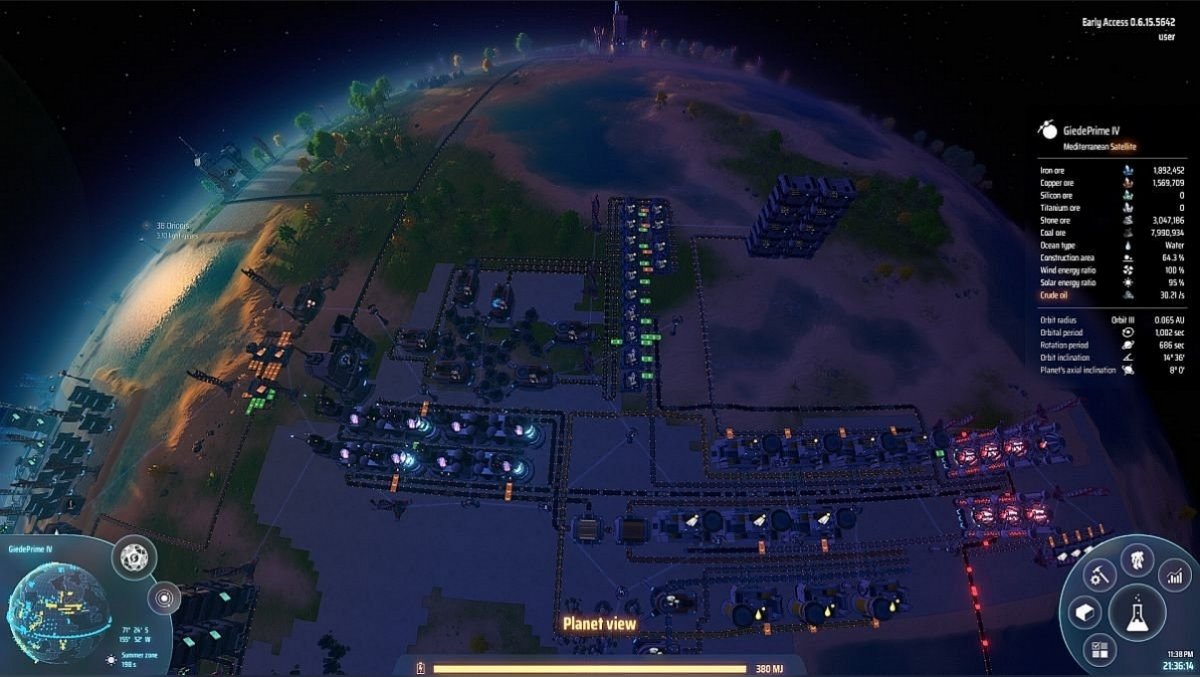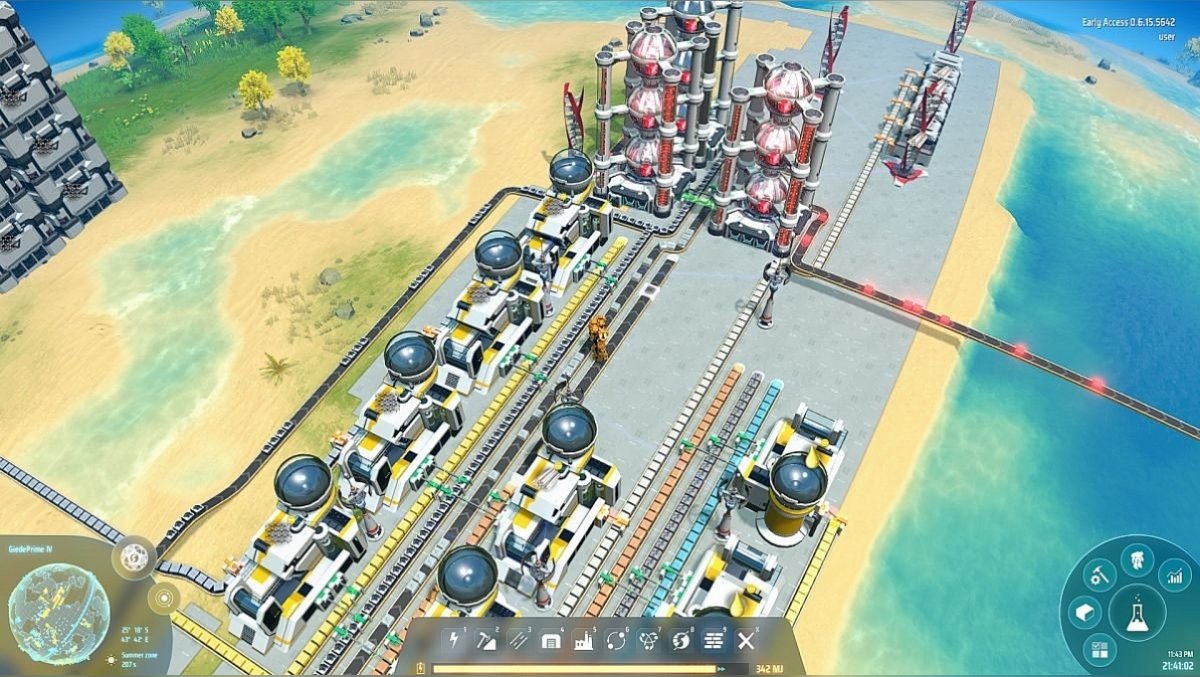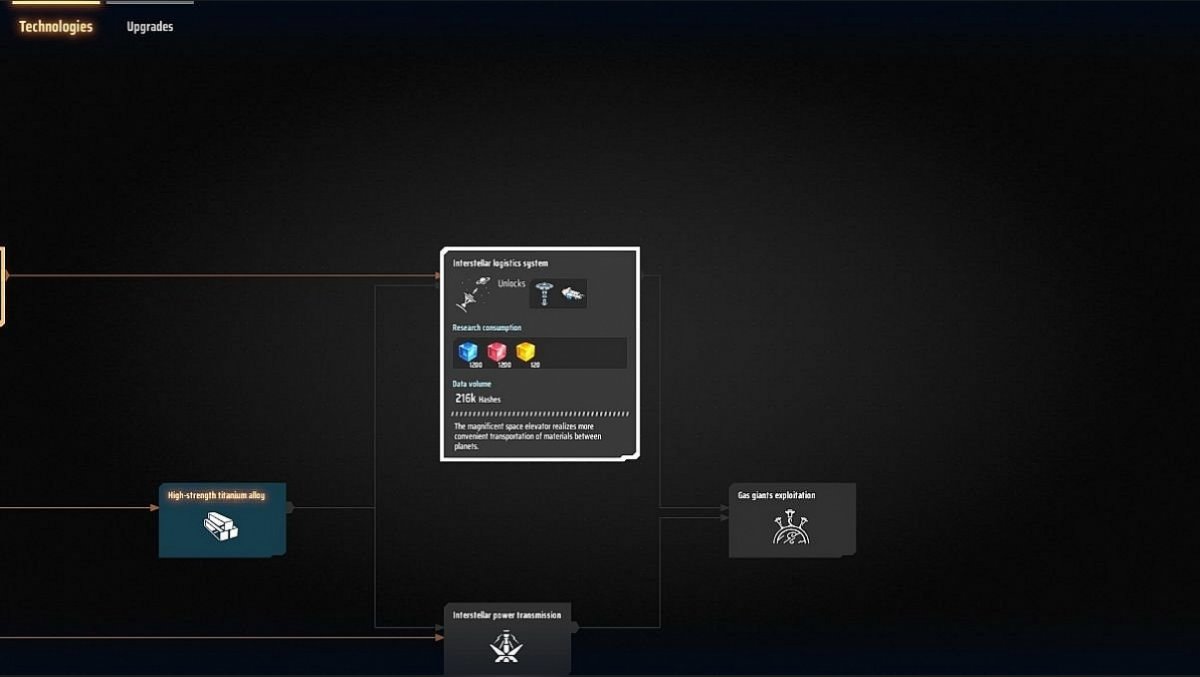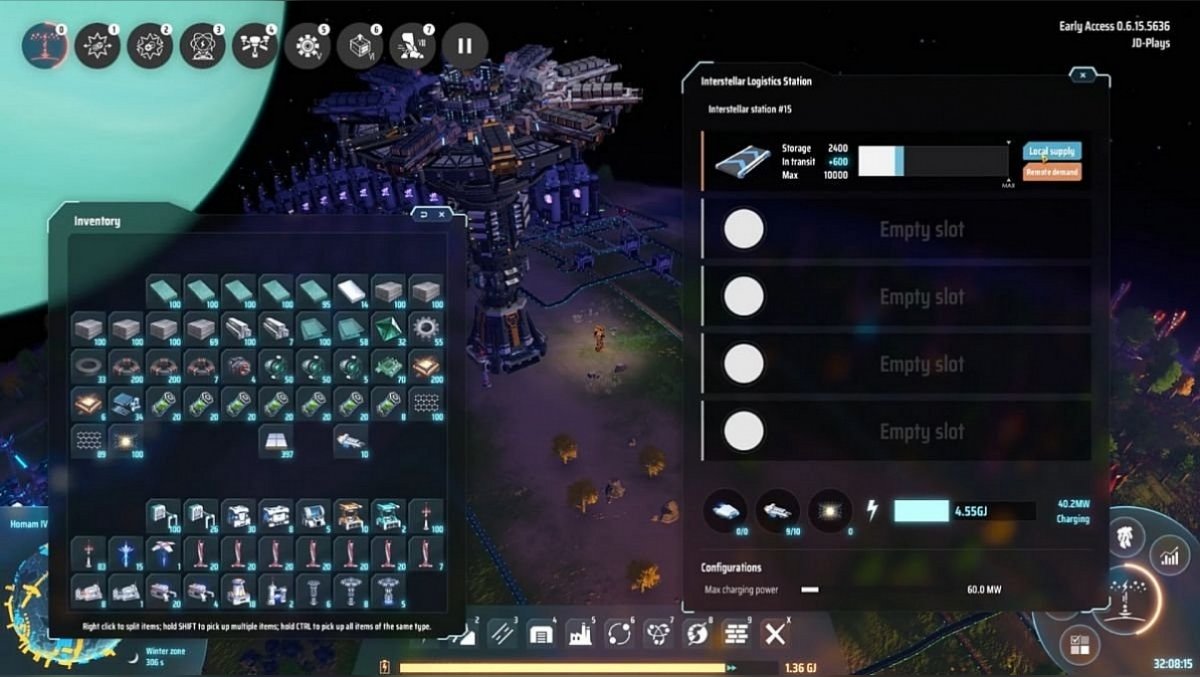Dyson Sphere Program logistics guide - how to transport resources around the planet, between planets and between the stars
IN Dyson Sphere Program the player needs to build a Dyson Sphere. An object of cyclopean dimensions around a star will require a huge amount of various resources. The starting planet will be just the beginning, in the future the planets of the local star will be conquered, and in the end mining in other systems will begin. And all these resources will have to be transported to the goal. How exactly - we will tell in this guide.
Dyson Sphere Program Gameplay Basics
But first, a few simple explanations for newbies. There are three main types of buildings at the heart of DSP gameplay:
- mining is either Mining Machines or Oil extractors;
- refining - smelters and oil refinery, where raw materials are converted into one or another basic resource - iron, steel, copper, silicon, doped oil, etc.
- recycling - Assemblers, Chemical plants and other complex plants where resources are processed into products. Products, in turn, are also processed from simple to complex, giving rise to increasingly complex iterations. For example, a conventional interstellar engine can be decomposed into hundreds of micro-motors, processors, electronic circuits, units of steel, plasma flasks, and so on.
Unlike other economic strategies, in DSP you build one huge factory, no matter how many millions of kilometers between resources and factories are located. And the basis of any factory is the exchange of goods. In classic games of the genre, exchanges are automated by bots or trade routes.
In DSP, you have to manually control the exchange using Conveyor belts and Sorter unloaders. The former only transport goods, the latter connect the tape with a specific building or warehouse. In addition, the sorter can have a filter and load / unload only a specific product.
To quickly complete the game, you need to correctly distribute production areas, correctly place buildings and optimally connect them with conveyor belts, while not forgetting to leave reserves. Indeed, as one of the already mastered resources develops, it may be required in another place, and it will have to be thrown there all through the same conveyor belt.
How to choose a starting location in the Dyson Sphere Program
In the Dyson Sphere Program, the game world is randomly generated, so explore the planet before doing anything. To do this, click on its icon in the lower left corner and use the middle mouse button to scroll:
In the table in the upper right corner, you can find out what this particular planet is rich in. Ores on the surface are marked by crystals protruding from the ground, and oil deposits - by short vents (poorly visible).
A good place to start would be where there are medium to large deposits of Iron, Copper, Stone and Coal in relative proximity.
One of the main rules of DSP is as follows: in any case, do not drag all resources to one point. The whole planet is at your disposal, there is enough space, do not save it. In your mind, break down each sector of the planet by region. Let in one you have the mining and processing of coal ore into coal and energy graphite. In another area - copper ore for copper. In the third sector - stone for building blocks and silicon. Leave enough space between them.
Follow another rule: it is easier to bring one resource to the desired point than to complete / rebuild an already finished one. For example, you will need electric motors very early - they are assembled from magnets and circuit boards. Copper, magnets and iron are required. So don't add new buildings to the original mining / processing areas. Do this in a new place, where you will bring conveyor belts with everything you need.
Fourth rule: build production chains from the equator to its pole. Due to the spherical shape of the map, there is a lot of space at the equator, which is well suited for the extraction of raw materials and their initial processing. You will have a huge variety of such buildings.
Closer to the poles, you will feel that the map is "running out", but there will still be enough space for the production of high-tech products. The required buildings are not required as many as for simple products.
In addition, by directing yourself towards the pole, you will avoid chaotic buildings, intersections with other areas and constant re-laying of conveyor belts.
And due to the third and fourth rules, you will have a better chance that the necessary resources will be on the same parallel, which means that the conveyor belt will be short and you will not have to drag this or that product, looping with a belt due to chaotic buildings.
Construction at the Dyson Sphere Program
We talked about the logistics strategy, now we will discuss tactics. For simple, unambiguous production, it is better to build conveyor belts with a snake, and place buildings in a row, parallel to the equator. For example, to obtain iron or silicon (in the screenshot):
Lay a conveyor (or maybe two belts) between the enterprises of the first level, where finished products will be stored. It will go to the entrance of second-level enterprises. This simple yet dense layout will save a lot of space. Expect to spend quite a lot of conveyor belt.
For the production of parts and components, you can use a linear arrangement: the buildings of the second stage come after the first, the third after the second, and so on. Build buildings on either side of the conveyor tire. Everything will look unnecessarily long, but the operation of the pipeline will be clear at a glance:
At the beginning of the game, the conveyor belt is slow, so be careful with long production chains. The required resource (graphite as in the screenshot) simply will not reach the last assemblers. In this case, draw another tape and connect it to the first in the middle or closer to the end:
In general, a second conveyor belt with a resource is always preferable to one accelerated one. Therefore, it is important to have enough free space, if not in the center, then around the production chain.
Another important rule is one resource, one tape. You should not load several or even all resources on one or two tapes at once, and then try to sort what you need. Firstly, this or that production chain can run into a limit and stop, thereby the conveyor will clog and stop the whole.
Secondly, it is difficult to control such a chain in dynamics - it is necessary to set filters everywhere and control their work. And it is also very difficult to promptly direct the required resource to another place on the map, you need a splitter with filters (Splitter). In general, don't make life difficult for yourself.
The conveyor belt can be freely raised to a height and carried over the building, over another belt along or across. The game determines the height itself, but at least you can adjust the levels yourself using the arrows on the keyboard.
And one more important simplification - build warehouses, at least for the final products at this stage of development. While you are busy with other things, production will work, and the warehouse will fill up. And when the time comes, you don't have to wait until the required amount of resources or materials is collected. Everything will already be in place, and you will save a lot of time. By the way, warehouses can be built one above the other:
No matter how skilled you are in logistics, there comes a time when it is unprofitable or simply problematic to drag goods from one point of the planet to another due to lack of space, congestion and crossings of belts. What can we say about the delivery of resources from other planets. In such a case, the developers have prepared separate game mechanics.
Planetary logistics
When you develop to the second level (red cubes), you will be allowed to establish direct communication between different regions of the planet with each other. To do this, you need to research the technology "Planetary Logistic System" (Intraplanetary Logistic System).
After completing your exploration, you will unlock the Planetary Logistic Station and the ability to produce Drones in assemblers.
At this stage of development, logistics stations and drones will ensure the transfer of resources only on the planet on which they are located. For the transportation route to work, you need 2 stations, one at the point of departure, the other at the point of receipt.
Each station can have an individual number of drones, from 0 to 50. If it is convenient for you, you can place the drones only at the sending or receiving station, but we still recommend placing them equally there and there.
The management of this system is quite simple. Bring the conveyor with the required resource to the dispatch station and remove the conveyor from the receiving station. And here and there, choose the resource that you want to transport. There will be only three cells for delivery, but the number of stations is not limited, that is, you can put another one next to another set of goods for transportation.
In the dialog menu of the station, pay attention to the button on the right, at the sending station there should be the supply mode (Supply), and at the receiving station - the request (Demand). Keep in mind that the request will be distributed all over the planet, and drones will fly to it from all stations where the supply mode is set. If there are several requests, and the distribution is from one point, the drones will be divided into several groups.
The more drones work on the staff of each station, the faster they will transport goods. The station also acts as a warehouse (Storage mode), where products can be stored in large volumes, waiting for dispatch.
One of the main drawbacks of the planetary logistics system can be considered the high cost of maintenance, the two stations required for cargo transportation will consume 120 megawatts of electricity, which is very sensitive at the beginning of the batch.
The consumption of titanium, processors and engines will increase, which will be useful to you in higher priority tasks. Drones are inferior in speed to the third level conveyor.
Star system logistics
However, you will not be able to sit on the same planet all the time. From the planetary stage, you will soon move on to mastering your star system. It will definitely have one planet with a scarce resource - titanium and silicon. If you are unlucky, then there will be two planets, on one there will be simply mountains of titanium, on the other - mountains of silicon.
When, at the second level of development, you open the opportunity to fly between planets, be sure to explore your star system, determine the reserves of rare ore on other planets, and only then proceed to colonization. But in any case, the first time you have to tinker, carrying titanium ingots on yourself.
This cannot go on for long, so the Dyson Sphere Program proposes to transport resources using the Interstellar Logistic System technology (yellow cubes are required). After completing your exploration, you will unlock the Interstellar Logistic Station and the ability to build full-fledged Logistics Vessel in Assembler.
In terms of gameplay, everything is almost the same as what we described above, but on a larger scale.
Build one station on the receiving planet (mode in the Remote Demand menu, "remote request") another - on the sending planet (mode in the Remote Supply menu, "remote delivery"). Connect the station to your factories with a send / receive conveyor. Choose the resource that you want to bring or take, charge both stations with 120 megawatts of electricity and add a dozen spaceships to the route. Now they will do everything on their own.
Interstellar stations have an advantage - they serve not only ships, but also ordinary planetary drones. This is the responsibility of the Local Supply and Local Demand modes. So one planetary logistics station is already at your disposal, and there is always a place to put the second one. But don't forget that drones and ships are not the same thing!
If you followed our advice from the beginning of the article, then one of the poles of the planet would be a good place to place such a station. At this point, your production chains will be close to the pole, so you don't have to pull a lot of conveyor belts to connect buildings of the end of the game to resources and goods obtained from abroad and on your planet.
Since this method of transferring resources has many disadvantages, it is more profitable to transport some processed products, rather than bare raw materials. It is much more profitable to transport refined titanium or silicon than titanium ore (Titanium ingot) or stone (Stone).
The interplanetary logistics station will also come in handy when servicing the Orbit collector, or, in a simpler way, the orbital collector of hydrogen and other gases. This structure, hovering above the gas giant, will bring many thousands of cubic meters of hydrogen in no time, so it would be best if you were among the first to open these structures.
Interstellar logistics
The organization and management of interstellar shipments is similar to what we have explained for interplanetary transport. At least that was the case in the version that was released in Early Access on Steam.
There is only one but. To move into warp space from one system to another, the Logistics Vessel needs a Space Warper - a very rare resource that is consumed one per jump. It is not so easy to get it, you will need to recycle scarce gravitational lenses or green cubes. Only together with it will the ships be able to bring especially rare resources from other star systems.
The point of combining interstellar stations with the functionality of interplanetary ones is that when receiving cargo from other stars / planets, you can use drones to immediately send them to the right place on your home planet if it is too far away.
And the last thing. In storage mode, neither station will send resources despite requests. But they will still accept them.
***
That's all. We hope we helped you figure out the logistics in the Dyson Sphere Program!

























Comments
Post a Comment